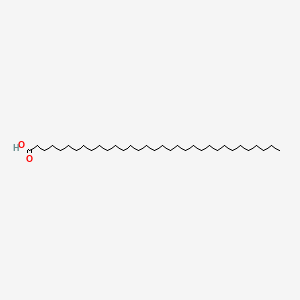| MeSH term | MeSH ID | Detail |
|---|---|---|
| Diabetes Mellitus, Type 2 | D003924 | 87 associated lipids |
| Body Weight | D001835 | 333 associated lipids |
| Hypercholesterolemia | D006937 | 91 associated lipids |
tritriacontanoic acid
tritriacontanoic acid is a lipid of Fatty Acyls (FA) class. Tritriacontanoic acid is associated with abnormalities such as hypercholesterolemia, Metabolic syndrome, Diabetes Mellitus, Non-Insulin-Dependent, Diabetes Mellitus, Insulin-Dependent and Parkinson Disease. The involved functions are known as Fermentation, Process, Longterm Effects, Pressure- physical agent and Lipid Metabolism. Tritriacontanoic acid often locates in Blood, Tissue fiber and A Fibers. The associated genes with tritriacontanoic acid are STN gene. The related lipids are Total cholesterol and blood lipid.
Cross Reference
Introduction
To understand associated biological information of tritriacontanoic acid, we collected biological information of abnormalities, associated pathways, cellular/molecular locations, biological functions, related genes/proteins, lipids and common seen animal/experimental models with organized paragraphs from literatures.
What diseases are associated with tritriacontanoic acid?
tritriacontanoic acid is suspected in hypercholesterolemia, Metabolic syndrome, Diabetes Mellitus, Non-Insulin-Dependent, Diabetes Mellitus, Insulin-Dependent, Parkinson Disease and other diseases in descending order of the highest number of associated sentences.
Related references are mostly published in these journals:
| Disease | Cross reference | Weighted score | Related literature |
|---|
Possible diseases from mapped MeSH terms on references
We collected disease MeSH terms mapped to the references associated with tritriacontanoic acid
PubChem Associated disorders and diseases
What pathways are associated with tritriacontanoic acid
There are no associated biomedical information in the current reference collection.
PubChem Biomolecular Interactions and Pathways
Link to PubChem Biomolecular Interactions and PathwaysWhat cellular locations are associated with tritriacontanoic acid?
Visualization in cellular structure
Associated locations are in red color. Not associated locations are in black.
Related references are published most in these journals:
| Location | Cross reference | Weighted score | Related literatures |
|---|
What functions are associated with tritriacontanoic acid?
Related references are published most in these journals:
| Function | Cross reference | Weighted score | Related literatures |
|---|
What lipids are associated with tritriacontanoic acid?
Related references are published most in these journals:
| Lipid concept | Cross reference | Weighted score | Related literatures |
|---|
What genes are associated with tritriacontanoic acid?
Related references are published most in these journals:
| Gene | Cross reference | Weighted score | Related literatures |
|---|
What common seen animal models are associated with tritriacontanoic acid?
There are no associated biomedical information in the current reference collection.
NCBI Entrez Crosslinks
All references with tritriacontanoic acid
Download all related citations| Authors | Title | Published | Journal | PubMed Link |
|---|---|---|---|---|
| Yu X et al. | Correlation between tissue metabolism and cellularity assessed by standardized uptake value and apparent diffusion coefficient in peritoneal metastasis. | 2014 | J Magn Reson Imaging | pmid:24170710 |
| Semwal R et al. | A gastroretentive drug delivery system of lisinopril imbibed on isabgol-husk. | 2014 | Curr Drug Deliv | pmid:24144200 |
| Cicero AF et al. | Nutraceuticals for metabolic syndrome management: from laboratory to benchside. | 2014 | Curr Vasc Pharmacol | pmid:23627983 |
| Kaialy W et al. | Psyllium: a promising polymer for sustained release formulations in combination with HPMC polymers. | 2014 | Pharm Dev Technol | pmid:23506265 |
| Saini S et al. | Comparison of 3% sorbitol vs psyllium fibre as oral contrast agents in MR enterography. | 2014 | Br J Radiol | pmid:25062448 |
| Yokoyama S et al. | Tongue pressure modulation for initial gel consistency in a different oral strategy. | 2014 | PLoS ONE | pmid:24643054 |
| Gharibzahedi SM et al. | Psyllium husk gum: an attractive carbohydrate biopolymer for the production of stable canthaxanthin emulsions. | 2013 | Carbohydr Polym | pmid:23399251 |
| Oka A et al. | An unusual case of a gastric foreign body. | 2013 | Gastroenterology | pmid:24409485 |
| Niu Y et al. | Effects of structural modifications on physicochemical and bile acid-binding properties of psyllium. | 2013 | J. Agric. Food Chem. | pmid:23286525 |
| Togawa N et al. | Gene expression analysis of the liver and skeletal muscle of psyllium-treated mice. | 2013 | Br. J. Nutr. | pmid:22874121 |
